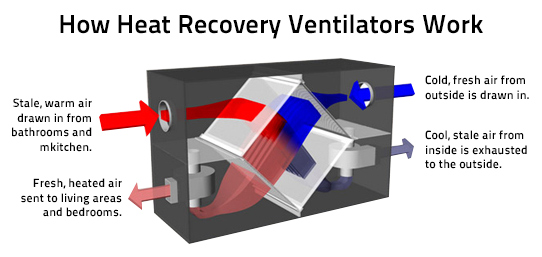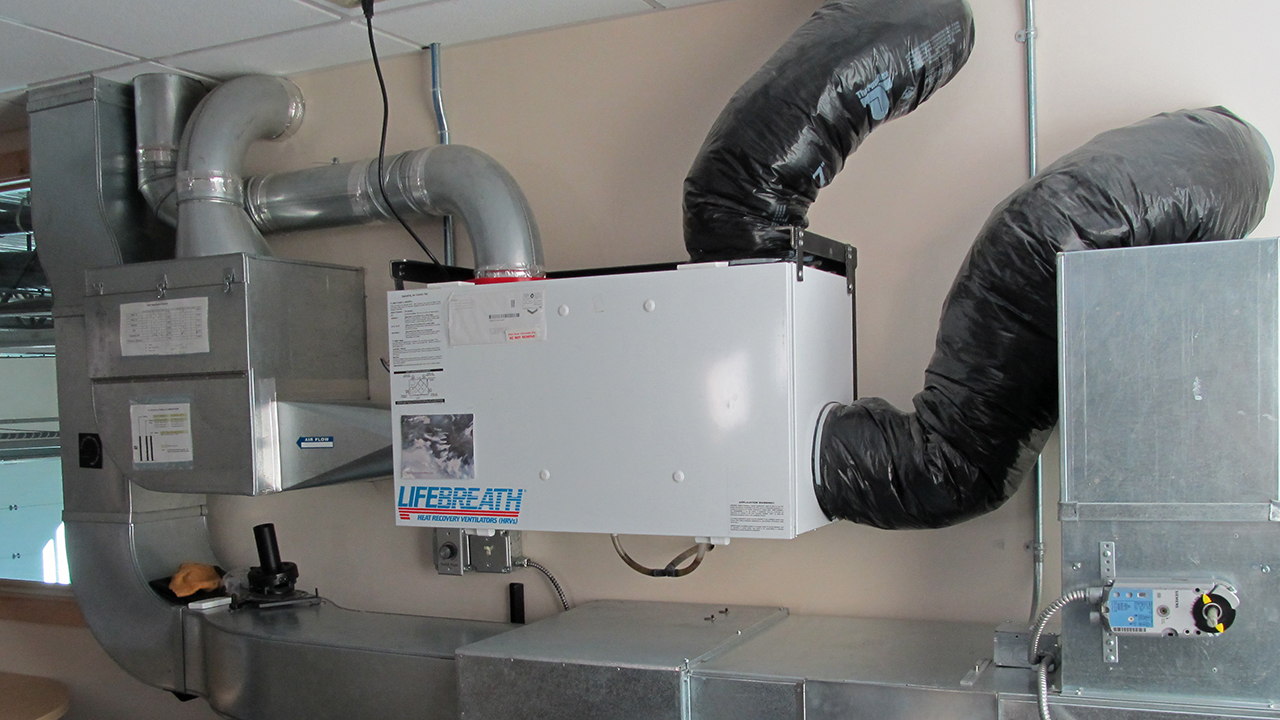Checklist: What to Consider Before Buying HRV
Wiki Article
Revealing the Trick Advantages and Uses of Heat Recovery Ventilation in Sustainable Style
Heat Recovery Ventilation (HRV) systems play an important role in lasting style. They help with a continual exchange of stagnant indoor air with fresh exterior air, significantly improving indoor air top quality. Moreover, HRVs add to energy performance by reclaiming warmth from tired air, which can decrease energy prices. Understanding the multifaceted advantages and applications of HRVs reveals their significance in modern style. What other advantages do these systems offer in the search of sustainability?Recognizing Heat Recovery Ventilation Equipments
Heat recovery ventilation (HRV) systems are developed to enhance indoor air high quality while minimizing energy loss. These systems make use of a mechanical air flow method to exchange stagnant interior air with fresh outside air, making certain a continuous supply of clean air. By recording heat from the exhaust air, HRVs prerequisite incoming air, decreasing the demand on heating and cooling systems. This procedure not just improves thermal comfort however additionally adds to energy effectiveness in household and commercial buildings. Furthermore, HRV systems aid regulate humidity levels and decrease indoor contaminants, advertising a much healthier living setting. Their strategic application is essential for achieving sustainable design goals, as they provide a balance in between power preservation and owner health.How HRV Solution Job
While lots of might know with air flow systems, recognizing just how heat healing ventilation (HRV) systems run is crucial for valuing their advantages. HRV systems operate by exchanging stagnant indoor air with fresh exterior air while moving warm between both streams. This process occurs in a heat exchanger, where heat from the outgoing air warms the inbound air throughout cooler months, lessening energy loss. Conversely, in warmer months, the system can cool down incoming air using the cooler outgoing air. HRVs are outfitted with fans to help with airflow and filters to get rid of particulates, guaranteeing a continuous, well balanced air flow process. This ingenious layout not just enhances energy performance however additionally adds to preserving a comfortable interior atmosphere.Enhancing Indoor Air Quality
Indoor air quality can significantly impact health and wellness and well-being, making efficient ventilation vital in modern homes. Heat Recovery Ventilation (HRV) systems play an important duty in preserving indoor air top quality by continually exchanging stale interior air with fresh outside air. This process not just decreases air-borne pollutants however likewise lessens moisture levels, which can cause mold and mildew development and respiratory concerns. HRV systems filter incoming air, removing allergens and particulates, thus providing a much healthier living environment. Additionally, these systems assist remove odors and unpredictable natural compounds (VOCs) generally found in house products. By making sure a constant circulation of clean air, HRV systems add to an overall better interior ambience, promoting comfort and health for occupants.Power Effectiveness and Expense Financial Savings
Energy effectiveness attracts attention as a substantial benefit of Heat Recovery Ventilation (HRV) systems. By capturing and reusing the warm from exhausted indoor air, HRVs lessen the power required for home heating inbound fresh air, bring about lowered energy consumption. This effectiveness equates into reduced energy expenses, offering considerable expense financial savings for property owners and services alike. In addition, HRV systems usually qualify for energy efficiency incentives and discounts, further enhancing their economic allure. Gradually, the first investment in HRV modern technology can result in a beneficial roi with lowered energy expenditures. As a result, the assimilation of HRV systems not just promotes lasting style however additionally gives a sensible solution for accomplishing long-lasting energy savings and financial advantages.Environmental Advantages of HRV

A wide range of environmental benefits arises from the execution of Heat Recovery Ventilation (HRV) systems. By successfully moving warm from exhaust air to incoming fresh air, HRVs considerably minimize the energy required for home heating and cooling down spaces. This energy effectiveness equates to lower greenhouse gas exhausts, contributing to a decrease in the total carbon impact of buildings. Additionally, HRV systems boost interior air high quality by continuously flowing fresh air, consequently decreasing the concentration of interior pollutants and irritants. The reduction in power usage help in preserving natural sources, making HRVs a crucial element of lasting style. Overall, the ecological advantages of HRVs play an essential duty in promoting a healthier world and cultivating environmentally friendly structure practices.
Versatile Applications in Modern Style
Heat recovery ventilation (HRV) systems are increasingly being incorporated into both household and commercial building tasks. In domestic settings, HRVs boost indoor air high quality while making the most of energy performance. In industrial rooms, these systems optimize air flow methods, demonstrating their adaptability in modern architectural applications.Residential Projects Integration
While modern architecture increasingly his explanation emphasizes sustainability, the assimilation of heat recovery air flow systems in domestic jobs has emerged as a useful remedy for improving indoor air top quality and energy efficiency. These systems effectively transfer warm from exhaust air to incoming fresh air, reducing power loss and lowering home heating or cooling down needs. In brand-new builds and retrofits alike, warmth recuperation air flow can be effortlessly integrated, supplying homeowners with a much healthier living setting while decreasing energy prices. In addition, with raising recognition of environmental impacts, more engineers and builders are recognizing the long-term advantages of these systems. As an outcome, warm recuperation ventilation has become an essential component of lasting property style, showcasing adaptability and commitment to environment-friendly methods.Commercial Rooms Optimization
As modern-day commercial rooms evolve to fulfill the needs of sustainability and effectiveness, the implementation of warmth healing air flow systems becomes a key approach for enhancing indoor settings. These systems assist in the exchange of stale interior air with fresh outdoor air while recovering heat power, substantially minimizing energy usage. This not just boosts comfort for owners however likewise aids in reducing functional costs. Functional applications can be observed in offices, retail areas, and universities, where air high quality and temperature level control are vital. Additionally, integrating warmth recovery air flow straightens with eco-friendly building certifications, additionally advertising environmental responsibility. Eventually, taking on such systems in business design not only adds to sustainability goals but also cultivates much healthier, a lot more productive spaces for users.
Integrating HRV Into Sustainable Design Practices
Incorporating heat healing ventilation (HRV) systems into lasting design methods supplies significant advantages in energy effectiveness and indoor air high quality. By making use of HRV, developers can create cost-efficient services that not just reduce power consumption but also boost the overall convenience of interior atmospheres. This alignment with sustainability goals settings HRV as a crucial part in contemporary architectural techniques.
Power Performance Enhancement
By incorporating warmth healing ventilation (HRV) systems into lasting style practices, engineers and building contractors can substantially improve power effectiveness in modern-day buildings. HRV systems function by recording warm from outgoing stagnant air and transferring it to inbound fresh air, lessening the energy needed for heating or cooling down interior spaces. This procedure not only lowers reliance on traditional cooling and heating systems yet also decreases general power consumption. On top important site of that, HRV systems can assist maintain a constant indoor temperature, lowering peak energy demands. By incorporating these systems, buildings can attain considerable decreases in utility prices and carbon impacts, straightening with sustainability goals. Eventually, HRV technology stands for a practical solution for improving power effectiveness in the built environment, advertising more responsible source usage.Indoor Air Top Quality Enhancement
Exactly how can heat recuperation air flow (HRV) systems contribute to superior indoor air top quality in modern structures? HRV systems successfully exchange stale indoor air with fresh outside air while recouping warm power, reducing temperature changes. This procedure reduces the concentration of interior pollutants, such as volatile organic substances (VOCs), allergens, and moisture, which can wear away air high quality and influence owner wellness. By maintaining perfect moisture degrees and making certain a continuous supply of clean air, HRVs help create a healthier indoor environment. On top of that, these systems can be incorporated right into lasting layout techniques, advertising energy efficiency together with improved air high quality. HRV Heat Recovery Ventilation. HRV innovation plays a crucial function in advancing overall owner convenience and wellness in modern building styles.Economical Style Solutions

Often Asked Questions
What Maintenance Is Required for Heat Recovery Ventilation Solutions?

Maintenance for heat recuperation ventilation systems generally entails regular filter substitutes, cleansing of heat exchangers, evaluation of fans and ducts, and making certain proper water drainage. These tasks assist keep effectiveness and lengthen the system's lifespan with time.
Can HRV Systems Be Set Up in Existing Structures?
Heat recovery ventilation systems can certainly be mounted in existing buildings. HRV Heat Recovery Ventilation. Retrofitting needs mindful preparation and analysis of the building's design, making sure compatibility with current systems while maximizing power performance and interior air top qualityJust How Do HRV Solution Influence Noise Levels Indoors?
HRV systems can influence interior sound degrees by presenting audio from exterior resources via ventilation. Nonetheless, premium setups usually incorporate sound-dampening functions, decreasing sound influence while providing efficient air exchange and maintaining comfort indoors.Exist Any Type Of Downsides to Making Use Of HRV Equipments?
The disadvantages of utilizing HRV systems include potential high initial costs, upkeep difficulties, and the opportunity of minimized indoor air high quality if filters are not on a regular basis altered, which might lead to concerns with moisture levels.How Do I Choose the Right HRV System for My Requirements?
Picking the appropriate warm recovery air flow system includes assessing specific demands, such as developing size, climate, and energy performance goals. In addition, examining system features, installment needs, and maintenance considerations is vital for peak performance and fulfillment.Report this wiki page